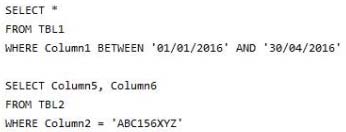

Note: This question is part of a series of questions that use the same or similar answer choices. As answer choice may be correct for more than one question in the series. Each question is independent of the other questions in this series.
Information and details provided in a question apply only to that question.
You have a Microsoft SQL Server database named DB1 that contains the following tables:
You frequently run the following queries:
There are no foreign key relationships between TBL1 and TBL2.
You need to minimize the amount of time required for the two queries to return records from the tables.
What should you do?
raja1234567890
Highly Voted 5 years agoHoglet
5 years agoLeonLeon
4 years, 11 months agoLuzix
4 years, 7 months agoAnette
4 years, 11 months agoChocho
4 years, 11 months agostm22
4 years, 11 months agoAghie
4 years, 5 months agoMML
4 years, 11 months agoMML
4 years, 11 months agoLeonLeon
4 years, 11 months agoKosteK
Highly Voted 4 years, 7 months agoAndy7622
Most Recent 4 years, 5 months agoeggzamtaker
4 years, 5 months agolh2607
4 years, 7 months agoOooo
4 years, 8 months ago